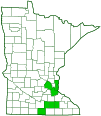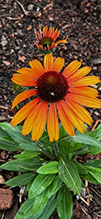American green crab spider
(Misumessus oblongus)
Conservation • Description • Habitat • Biology • Distribution • Taxonomy
|
|
||||||||||||||
Description |
American green crab spider is a small bristly spider. It occurs in the United States and southern Canada east of the Great Plains, and in northern Mexico. It is uncommon in Minnesota, where it reaches the western extent of its range. It is found from May through August in prairies, fields, and woodlands. The female is 3⁄16″ to ¼″ (4.45 to 6.01 mm) in length. There are numerous bristles on the body. The plate (carapace) covering the front part of the body (cephalothorax) is low, convex on the sides, and about as long as wide. It is pale green to dull yellow or red. It has no spots or longitudinal bands. It has a few spines but is nearly devoid of erect stiff hairs (setae). The abdomen is flattened, broadly oval, and widest near the rear. It is usually white, often pale yellow, sometimes yellow. There are sometimes broad red bands on the lateral margins. The legs match the carapace in color. The front two pairs of legs are thicker and much longer than the others, and are normally held out and forward, like a crab. This is the feature that gives the family Thomisidae its common name. There is a pair of minute claws at the end of the legs but these are not visible without magnification. There are eight eyes arranged in two curved rows of four. All of the eyes are on low raised projections (tubercles). The area enclosed by the eyes is often entirely white, pink, or red. On most individuals, at least some of the the tubercles are white or pink. In the front row the outermost eyes, the anterior lateral eyes (ALE), are a little larger than the interior eyes, the anterior median eyes (AME). In the back row the posterior lateral eyes (PLE) are directed sideways and backwards. They are not visible when the spider is viewed from the front. The jaws (chelicerae) are small and have no teeth. The male is much smaller, ⅛″ (2.56 to 2.96 mm) in length. The carapace has a few erect setae and has thin red bands on the lateral margins. The abdomen has a sparse covering of short setae and no red bands. The legs have dark red bands. |
Size |
Female Body Length: 3⁄16″ to ¼″ (4.45 to 6.01 mm) Male Body Length: ⅛″ (2.56 to 2.96 mm) |
Web |
Crab spiders do not make webs. |
Similar Species |
Habitat |
Prairies, fields, and woodlands |
Biology |
Season |
May through August |
Behavior |
When the legs are held out to the side the spider is able to walk forward, backward, or sideways (laterigrade). When hunting, the spider will sit, often in a flower and often for hours, waiting in ambush for prey. The female does not build webs, snares, or retreats. To protect its egg sac it will fold over the edge of a leaf and secure it with silk. |
Life Cycle |
The male is tiny compared to the female. To mate without first being eaten, it must first tie up the female with silk. After mating, the female easily breaks the restraints. |
Food |
Insects and other spiders |
Distribution |
||
|
Sources |
|
| 7/1/2024 | ||
Occurrence |
||
Uncommon in Minnesota |
||
Taxonomy |
|
Class |
|
Order |
|
Suborder |
Araneomorphae (Typical Spiders) |
Infraorder |
Entelegynae |
Superfamily |
Thomisoidea (crab and running crab spiders) |
Family |
Thomisidae (crab spiders) |
Subfamily |
Thomisinae |
Tribe |
Misumenini |
Genus |
Misumessus |
Until recently, this was the only species in the subgenus Misumessus of the genus Misumenops. In 2008 the subgenus was raised to genus level. Until 2017 it remained the only species in Misumessus. |
|
Subordinate Taxa |
|
|
|
Synonyms |
|
Misumena americana Misumena oblonga Misumenops oblonga |
|
Common Names |
|
American green crab spider green crab spider pale crab spider |
|
Glossary
Carapace
The hard, upper (dorsal), shell-like covering (exoskeleton) of the body or at least the thorax of many arthropods and of turtles and tortoises. On crustaceans, it covers the cephalothorax. On spiders, the top of the cephalothorax made from a series of fused sclerites.
Cephalothorax
The front part of a spider’s body, composed of the head region and the thoracic area fused together. Eyes, legs, and antennae are attached to this part.
Chelicerae
The pair of stout mouthparts, corresponding to jaws, in arachnids and other arthropods in the subphylum Chelicerata.
Seta
A stiff, hair-like process on the outer surface of an organism. In Lepidoptera: A usually rigid bristle- or hair-like outgrowth used to sense touch. In mosses: The stalk supporting a spore-bearing capsule and supplying it with nutrients. Plural: setae.
Tubercle
On plants and animals: a small, rounded, raised projection on the surface. On insects and spiders: a low, small, usually rounded, knob-like projection. On slugs: raised areas of skin between grooves covering the body.
Visitor Photos |
||
Share your photo of this arachnid. |
||
This button not working for you? |
||
Julie P |
||
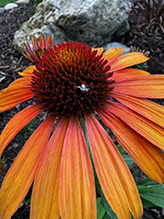 |
||
Sis |
 |
Alfredo Colon |
||
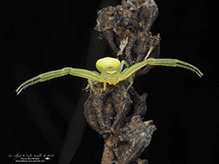 |
||
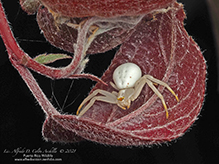 |
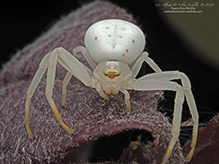 |
|
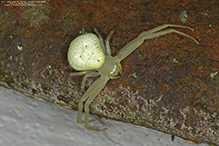 |
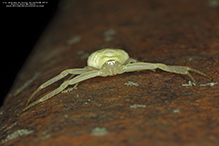 |
|
MinnesotaSeasons.com Photos |
||
|
||
|
||

Slideshows |
|

Visitor Videos |
||
Share your video of this arachnid. |
||
This button not working for you? |
||
|
Other Videos |
||
FREE HANDLING A AMERICAN GREEN CRAB SPIDER (misumessus oblongus) |
About
Aug 3, 2020 Hey guys. So today's free handling video is me free handling a american green crab spider. This spider was calm as the Spitting spider, but wouldn't move that much. I hope you guys enjoyed today's video. Like and Subscribe, turn on notifications and I'll see you guys tomorrow. Bye. 🌟🌟🌟🌟🌟 |
Flower Crab Spider (Misumessus Oblongus) Female |
About
Aug 8, 2016 |

Visitor Sightings |
||
Report a sighting of this arachnid. |
||
This button not working for you? |
||
Julie P |
Location: Lake St. Croix Beach, MN |
 |
Sis |
Location: Lafayette, Indiana |
| Alfredo Colon 8/8/2022 |
Location: Albany, NY |
 |
| Jon Nicholson 8/5/2022 |
Location: New Hartford Twp., Winona County, inside home |
|
| Alfredo Colon 5/30 to 6/1/2021 |
Location: Woodbury, MN |
 |
| Alfredo Colon August 2019 |
Location: Slinger, Wisconsin |
 |
MinnesotaSeasons.com Sightings |
||
|

Created: 8/21/2021 Last Updated: © MinnesotaSeasons.com. All rights reserved. |
